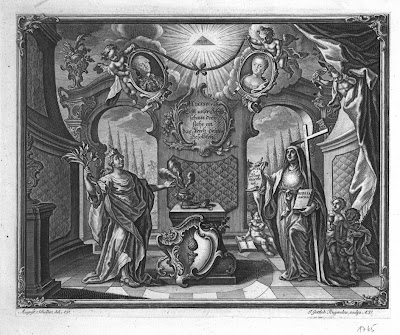



















[mouseover for date/caption and click to enlarge to full size]
'Sammlung aller Denkmale des Westphälischen Friedens' contains 140 engravings and was assembled between 1650 and 1789. The book is online at the University of Augsburg (click on 'anzeigen' for the complete thumbnails)
It was a very odd experience looking through this extraordinary album on the first occasion from a point of complete ignorance. I saw 'Westphalia' and 'pax' around so I guessed it had something to do with the 1648 Peace of Westphalia. I originally thought it was a kind of regional chronicle, but for every depiction of what I guessed was a local building or town meeting, there were these eccentric allegorical engravings, packed full of emblematic puzzles and otherworldly motifs.
The further you go further through the book the more the images become demonstrably biblical (probably not as well represented above), but even then, they're often associated or seem to be associated with regional Germany. That's not always true - there are a fair number of more naturalistic illustrations obviously set in the middle east but it was still quite weird; if I hadn't had some background christian religious knowledge I'd swear everything in the bible took place in the Westphalian region of Germany. {What is Jesus doing in a pharmacy?!}
And of course, now that I've recounted my own strange meeting with this work, you'll be able to go through and see how unfounded or foolish were my initial reactions. They have a lot to do with the way I stumble across oddities accidentally and the evolving response that follows before I start trying to search/translate my way out of a {happy} state of dazed curiosity.
Even now I'm only vaguely aware that some sort of young person's evangelical religious group commissioned or assembled or contributed to this century and a half of commemorative imagery and it's not altogether certain that each piece of work was completed in the stated year.
I'm hoping that a benevolent german speaking visitor to this site will be able to provide a bit more background via a comment or email. Title pages: I, II. Each of the images above is worth enlarging to see all the baroque accoutrements and complex allegorical tropes, with the occasional monster and star wars jet fighter thrown in to compound the intrigue. This is the bread and butter of a satisfying BibliOdyssey.
skip to main |
skip to sidebar


analytics
Books~~Illustrations~~Science~~History~~Visual Materia Obscura~~Eclectic Bookart.

Contact | Who?
Recommended Blogs
Blog Archives
Resource Sites
- digital nz
- library of congress
- british library
- library france
- library holland
- library spain
- library portugal
- european library
- library australia
- collections canada
- digital poland
- nypl digital
- botanicus digital
- v&a collections
- britmuseum prints
- smithsonian search
- smithsonian galaxy
- f.a.m.s.i.
- casglu'r tlysau
- rumsey collection
- manuscript catalogue
- digital scriptorium
- cesg manuscripts
- swiss manuscripts
- pecia mss blog
- digital book index
- rare book room
- online exhibitions
- primary sources
- worldcat search
- library directory
- digital librarian
- intute resources
- warburg institute
- lexilogos links
- digiwiki links
- museum blogs
- book arts web
- culture archive
- conservation articles
- art-history timeline
- visual arts
- arts journal
- artcyclopedia
- ukiyo-e
- calligraphy megapage
- penmanship
- woodblock
- coconino
- alchemy website
- health hist. img-banks
- health history links
- history network
- new advent


















2 comments :
Well, as you are asking for background - I cannot rightly provide that. But what I actually can do is translate that rather long baroque title of the work.
On title page I it says: Collection of all Monuments (I suppose what they mean is commemorative stuff in general) of the Peace of Westphalia that have been provided to the evangelical youth at Augsburg from 1650 to 1789, mainly consisting of biblical peace paintings.
Above that, it quotes the Epistle to the Ephesians 6,4. Below it says that it has been "besorgt" - an old German usage for "created" by the Barefooted Agustinians. Their chruch in Augsburg is this one.
The second page provides a little more insight: Apparently there has been a "Kinder-Friedens-Fest" (Children's Peace Festival) in Augsburg every year since 1650, and every year the children would be given one of those paintings which were created as a way of giving thanks to go for the Peace of Westphalia. The prints would be accompanied by an explanatory notice and also be explained in a sermon.
The works have been "collected by popular demand" by one Johann Michael Roth.
That's all I can gather from this, hope it helps shed a little light.
Thanks a lot madcynic - that fills in some opaque details. I couldn't quite work out what the children had to do with this. It was quite an unusual (from this vantage point) phenomenon although I daresay there are modern equivalents. Cheers.
Post a Comment
Comments are all moderated so don't waste your time spamming: they will never show up.
If you include ANY links that aren't pertinent to the blog post or discussion they will be deleted and a rash will break out in your underwear.
Also: please play the ball and not the person.
Note: only a member of this blog may post a comment.